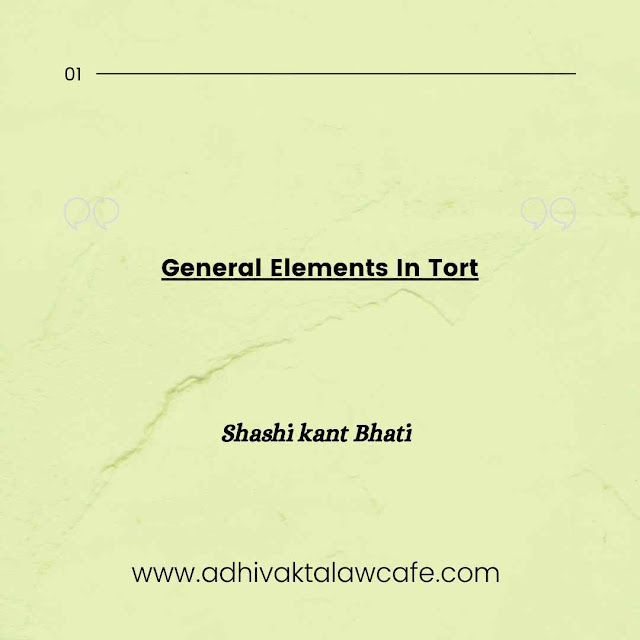GENERAL ELEMENTS IN TORT
There are two basic elements in Tort, Namely Act or Physical Element and Mental Element.
Physical Element
Act refers to movement of body, living or dead, or a part of it, but not merely a thought, intention or a dream. Act, in common parlance, denotes activity or action. But legally, Act can be both positive as well as negative. That is, in law, Act includes omission. One maysaythat even when one chooses not to act, he infact acts the other way round or the act is one of rest or lethargy. Acts and omissions may be understood as events under Human control as against Natural events such as rising of the Sun, Earthquake etc.
Any act cannot amount to tort unless it is done or in negative sense, where it was a duty, the same is omitted. A mere thought or intention or ill-will towards someone without any action in furtherance of it cannot amount to Civil Wrong. Though mere sharing of such idea or thought, in certain cases,may be sufficient to be held liable. In such cases, the sharing is sufficient act.
It is worth noting that although act includes omission but the law generally does not impose liability for omission. But where the law lays down a duty of action, its omission is accountable under the law.
Take, for example, a person “A” is drowning in a Pool. A person “B: standing nereby and watching the incident and despite having the ability to save the first person, omits to do so. B incurs no liability unless he was appointed as a Life-guard, in which case it would have been his duty to try and save the person from drowning.
Futher, an act may be voluntary or involuntary. Voluntary means originating out of volition i.e. something one chooses to do or not do, over which the person has control although all its results may not be foreseen.
Involuntary acts are those where the actor lacks the power to control his actions and involuntary omissions are those where the actor’s lack of power to control his actions renders him unable to do the act required. An Involuntary act does not give rise to any liability.
Mental Element
To bring an action under Tort, the act must be voluntary coupled with a mental element such as Malice, Intention, Negligence or Motive. The only exceptions are Strict and Absolute Liability, to which we shall come to at a later stage. First, we shall see different mental elements.
-
Malice
Malice means ill-will. In law, it is used in two different senses. Firstly, Intentional wrong or Malice in Law. It refers to an act done wrongfully, and without reasonable and probable censure, and not, as in comman parlance, an act dictated by angry feeling or vindictive motive. It is in its nature implied i.e. law infers it from circumstances. Secondly, Malice may refer to improper motive or Malice in Fact.
-
Intention
Intention is an internal fact. It is what goes in the mind of the doer and no direct evidence of the same is available. In an intentional act, the doer has both the knowledge and desire of the consequences.
-
Negligence
An act is negligent when the consequences are not adverted to though a reasonable person would have foreseen them. For example, Driving a car fast on a busy lane. Though the driver may not intend causing harm to anyone, but a reasonable person can foresee such a catastrophe.
-
Recklessness or Gross Negligence
When the consequences are adverted to though not desired and there is indifference towards them or willingness to run the risk, it amounts to recklessness. It is often equated with Intention because the negligence is so gross, it is deemed that the person intended the very act or consequence.
-
Motive
Motive is the ulterior object or purpose of doing an act. It differs from Intention which is immediate. It is the motive that gives rise to Intention and not the other way round. Motive is concrete Intention is abstract. Motive is driving force behind all actions.
Generally, Motive is irrelevant. A person may cause injury to another despite having best of motives. Also, an an action may be perfectly legal despite bad motive. The law has greater regard for the act itself rather than its motive.
Illustration:
If a man throws a stone at a woman, his trespass to her person is intentional; that he threw it because she had jilted him would be motive and immaterial as such. If he did not throw the stone for purpose of hitting her but ought to have foreseen that it was likely that the stone could hit her, his act would be un-intentional but nevertheless negligent. If the stone hit her solely because it rebounded off a tree at which it he had thrown it his conduct would be voluntary and hit accidental. But if, while he was holding the stone in his hand, a third party seized his arm and by twisting it compelled him to release his hold on it, whereupon it fell on the woman, his conduct would be involuntary and could never give rise to liability on his part.
CLASSIFICATION OF TORTS
All torts can be classified into three broad categories:
(1) Malfeasance
These are unlawful acts and are actionable per se, that is, without proof of negligence;
(2) Misfeasance
Misfeasance is improper way of doing the act which cause damage. This happens when one’s action is the result of
negligence;
(3) Non-feasance
Non-feasance is wrong of omission. A suit does not lie for them unless the law imposes a duty to act.
